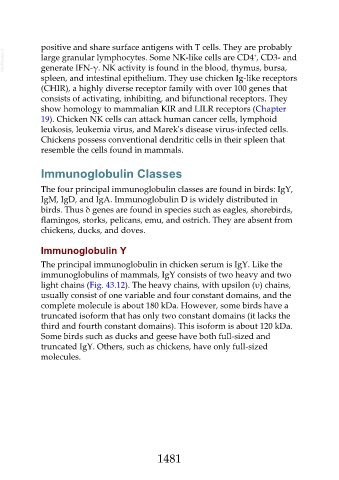Page 1481 - Veterinary Immunology, 10th Edition
P. 1481
positive and share surface antigens with T cells. They are probably
VetBooks.ir large granular lymphocytes. Some NK-like cells are CD4 , CD3- and
+
generate IFN-γ. NK activity is found in the blood, thymus, bursa,
spleen, and intestinal epithelium. They use chicken Ig-like receptors
(CHIR), a highly diverse receptor family with over 100 genes that
consists of activating, inhibiting, and bifunctional receptors. They
show homology to mammalian KIR and LILR receptors (Chapter
19). Chicken NK cells can attack human cancer cells, lymphoid
leukosis, leukemia virus, and Marek's disease virus-infected cells.
Chickens possess conventional dendritic cells in their spleen that
resemble the cells found in mammals.
Immunoglobulin Classes
The four principal immunoglobulin classes are found in birds: IgY,
IgM, IgD, and IgA. Immunoglobulin D is widely distributed in
birds. Thus δ genes are found in species such as eagles, shorebirds,
flamingos, storks, pelicans, emu, and ostrich. They are absent from
chickens, ducks, and doves.
Immunoglobulin Y
The principal immunoglobulin in chicken serum is IgY. Like the
immunoglobulins of mammals, IgY consists of two heavy and two
light chains (Fig. 43.12). The heavy chains, with upsilon (υ) chains,
usually consist of one variable and four constant domains, and the
complete molecule is about 180 kDa. However, some birds have a
truncated isoform that has only two constant domains (it lacks the
third and fourth constant domains). This isoform is about 120 kDa.
Some birds such as ducks and geese have both full-sized and
truncated IgY. Others, such as chickens, have only full-sized
molecules.
1481

